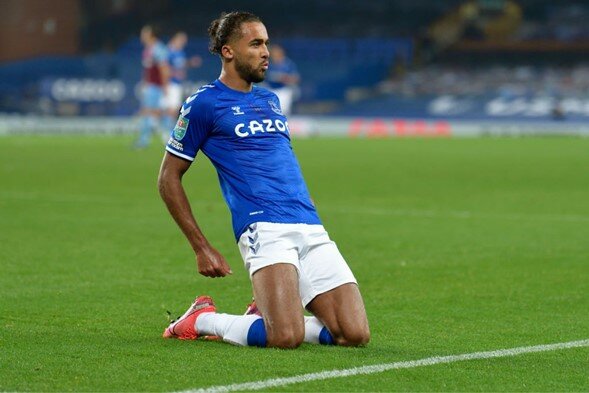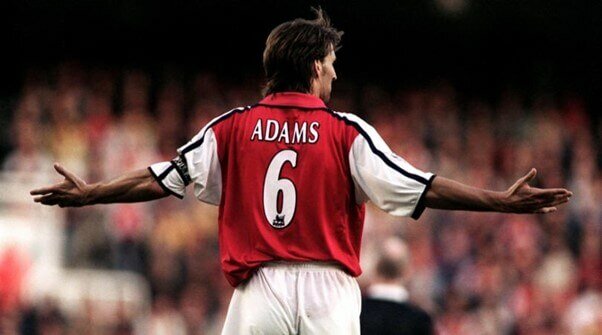Here’s Why Dominic Calvert-Lewin Is The Real Deal
MAHADEVAN SANKAR | 28th December 2020

When you see a flower bloom, there’s nothing like it. Much like flowers, people also need to go through some sort of a blooming process. Yes, it may not be the same kind of process but the end result is the same: change. And positive change. But for one to see and feel growth, how you deal with adversity is a gamechanger.
A bulk of research shows you that when people are put in situations where they are expected to fail, their performance does plummet. And everyone’s had their “palms are sweaty, knees weak, arms are heavy” moments. Minus the vomit on the sweater, of course. When they’re expected to win on the other hand, B-Rabbit turns into Eminem.
In footballing terms, witnessing a player’s development can be satisfying but it is fraught with difficulty too. As the expectations rise, so does our investment of emotions on said player. The temptation is to believe that a player’s output is fixed. Football fans have a tendency to put glass ceilings on development and ever so often, it becomes tough to even fathom that there’s potential to break that ceiling. But, even before one considers the inevitable peaks and troughs, progress is not linear. It never is.
To say that the meteoric rise of Dominic Calvert-Lewin has been coming would be disingenuous. He is no Jamie Vardy, rising from obscurity to having the world at his feet. His pedigree has long been clear. But nobody could have anticipated the impact he has made this season.
Having failed to score a single goal in 11 League One appearances for his boyhood team, Sheffield United, he managed only 11 in 78 Premier League appearances in his first three seasons at Everton after U-23 coach David Unsworth recommended his signing, following their time together at Bramall Lane. That is, until he came under the tutelage of one of the world’s most decorated managers – Carlo Ancelotti.
The Italian maestro has worked with some of the game’s best, during his tenure at the world’s best clubs. From Milan to Madrid and London to Paris, the list of illustrious marksmen includes Andriy Shevchenko, Didier Drogba, Cristiano Ronaldo and Zlatan Ibrahimović. That’s some list.
“When he came in and said he was not interested in bringing in anyone else, it was just another confidence boost at that moment to help me keep playing well.”
While Calvert-Lewin has won his fair share of plaudits, there are the inevitable doubters. For a striker that used to fail to score, is it just a hot streak? Is this level of form sustainable? Has there been genuine evolution in his game?
Here’s diving head first into every murmur and doubt out there.
The Fundamentals
The one thing that immediately stands out while watching DCL is his sheer physicality. Standing at 6’2 tall with a hulking frame, the young Yorkshireman is physically gifted enough to lead the line for any club in the world. Not only this, but he also has impressive speed and a motor, which lends itself perfectly to the type of player that he is. His pace and power gives his team the perfect out ball under pressure. Having spent a significant portion of his developing years as a central midfielder, Calvert-Lewin possesses good close control, vision and passing – but it is his burst of pace and aerial ability that have most helped his development as a centre-forward.
Given he is also comfortable with the ball on the floor, both coming deep and running in behind, the young No.9 gives defenders a great deal to think about when they encounter him. Few other centre-forwards possess such an extensive all-round game.

As any striker would do, DCL tried to claim Holding’s own goal. Goal or no goal, he proved why he’s so much more than just any No.9
The sheer combination of his impressive leap and size makes him one of the most dominant aerial forces in the league since Troy Deeney’s time in the division, providing a stern test to certain Premier League oppositions and their cojones. He enjoys the sort of old-school battles that defenders and attackers embark upon. Having forged his formative years in the lower divisions, young Dominic can handle these types of skirmishes. He is a constant nuisance for defenders, similar to the likes of Jamie Vardy and Alan Smith before him.
“I’ve always felt I’ve enjoyed the physical battle and enjoyed the tough tests. I’ve still got the scar under my eye from the first 20 minutes of playing for Stalybridge [against Hyde United].”
Running the channels constantly to create space for team-mates operating behind the frontline, Calvert-Lewin already excels in the art of stretching defenders and dragging them away from their posts. When sought out by long raking passes into the space behind the opposition, his speed and strength not only give him the advantage in terms of getting to the ball first, but also retaining possession when doing so. Due to DCL’s excellent physical attributes, through balls are proving to be the best way to exploit his speed and strength.
The England international can provide flick-ons for a strike partner or supporting runners, he can pull out wide before running at defenders, withdraw to link play with a midfielder, hang on the shoulder of the last man and look for balls in behind or into the channels, hold the ball up and bring others into play. Yes, there’s a lot to the lad.
The Signs

(Sky Sports)
Under the largely ineffective campaigns under Sam Allardyce and Marco Silva, we have a general idea on how Calvert-Lewin was being used on the pitch. Like most other young strikers, he was initially deployed out wide, mostly on the right side of the attack. While he provided much needed energy, DCL’s unnatural position meant he was farther away from goal.
Calvert-Lewin has very much had to fill in the gaps in the squad rather than carve out a set position for himself: right wing-back, right-wing, left-wing and centre-forward, the Everton man has been used in each role whilst playing most regularly in the latter. The appointment of Allardyce cemented his place in the side, charged with hassling and harrying opposition defenders whilst also providing a direct outlet for the likes of Rooney and Sigurðsson to seek out with direct balls into the channels.

Under Silva, he largely served as backup to Cenk Tosun. While he met the profile that the former Watford boss demanded from his forwards, he was not trusted enough to play up front. This wasn’t because he wasn’t a good enough finisher to lead the line. A look at his shot chart under the Portuguese manager indicates that while the vast majority of his efforts came from inside the penalty box, these were not easy opportunities. Many were contested headers from a zone where it was difficult to beat the goalkeeper.
The issue was not the quality of finishing but the quality of the chances.
The short-term appointment of Duncan Ferguson, taking over from the Portuguese, proved to be a turning point in Dominic’s career. The club legend gave Calvert-Lewin a new lease of life.
“He told me to believe in my stature, and back my strength, I think it’s a confidence thing. Once you realise you can do it once, you start to do it more consistently, and then it becomes part of your game, which I think is what has happened.”
The Takeover

The arrival of Carlo Ancelotti meant there were clamors to sign a new center forward but the Italian put his belief in Dominic and the results are there for all to see.The Italian gaffer initially set up in a 4-4-2 formation, pairing Calvert-Lewin with Richarlison up front. With the fullback pair of Lucas Digne and Seamus Coleman bombing forward, there was a regular supply of crossses in the box, which suited the lanky striker’s game.
“He is fantastic with the head, clever in the box and sharp. I think he is going to be at the top in England and in Europe.”

As we look at the heat map for his current season, we can see he still does work on the right-hand channel. But the difference is his positioning, which is more towards goal. Off the ball, Calvert-Lewin and Richarlison are positioned in the wide channels. This is to provide that out ball for the defence as mentioned earlier.
The combination of his raw pace and sheer physicality means Everton can relieve pressure by tasking Dominic Calvert-Lewin to hold up the ball higher up the pitch.

The key to his explosion as one of the most dangerous forwards in the league has to be his improved positioning in the box. The 23-year old has been a lethal penalty box poacher. This year especially, the creativity in the Everton team, since the arrival of the talismanic James Rodríguez means he can work on getting into better positions in the box. Most of his goals have come close to the penalty spot and in the 6-yard box, highlighting his improvement in movement.

DCL’s shot map shows you the zones where he causes mayhem (Understat)
From finishing first-time shots to minimal touches before getting off a shot in the box, DCL’s game has a sense of directness that stems from knowing exactly what he offers like it didn’t before. This sense of identity can be attributed to Don Carlo understanding how he profiles like nobody else or it’s just proof of an immense workrate that’s made him one of the most complete strikers on the planet, form-wise. Most likely, it’s a bit of both.
Looking at the stats, he has a higher % of his shots on target than any other season. Elite goalscorers score goals consistently when they regularly manage to keep the shot on target. Ancelotti has highlighted Pippo Inzaghi as a reference point in Calvert-Lewin’s increased improvement inside the box.
“Funnily enough, he mentioned it to me before he came out and said it in the press, I had a little YouTube of his goals and I watched a 15-minute reel of him. A lot of his goals are one-touch finishes and he has got great movement.”
It can be argued that Calvert-Lewin is already an elite level striker because of his heading ability. This particular facet has been key in elevating his game so far. No other forward in the league has as many headed goals as him since last season. He shares similarities with Cristiano Ronaldo, in how both of them use their physical gifts to generate power in the headed shot. Like Cristiano, Dominic has an incredible leap that allows him to reach almost any ball quicker than his marker.

If we analyze most of his headed goals, the one key feature that stands out is his positioning. Dominic never takes headers from a standing position as that’s not the most suitable position to generate power. Instead, he moves towards the flight of the ball, generating momentum as he meets it. Even when he meets it, he does so with his forehead. As this part of the head covers a large surface area, he is able to change directions of his headers while maintaining momentum to generate power on his headers.
“I am evolving as a centre-forward and I am honing my craft. Beforehand, I was guilty of doing a lot of my best work away from the goal. Now I am focusing on getting between the sticks and putting the ball in the back of the net.”
The Future
Even with the increased expectations on him moving forward, there is very little to suggest that the Englishman is going through a hot streak. I believe this version of him is here to stay. This is particularly because of his impressive work ethic, on and off the pitch. The lad is a student of the game and his improvement year on year is a testament to the heights he can achieve in his prime. Like his idol Drogba, there are certain similarities in how both exploded on to the season as goal scorers.
Richarlison shed light on the transformation he has seen behind-the-scenes.
“He’s transformed into a complete striker. I remember when I got here, he was nothing like the player he is today. It’s down to the work he’s put in. He’s in the gym every day, he’s always working on his finishing. And playing under [Carlo] Ancelotti, he’ll keep getting better and better. “
With his contract running until 2025, DCL has certainly committed himself to the present project at the club. For any interested party to prise him away, it would most certainly require a British record fee. As money is not an obstacle for Everton owner Farhad Moshiri, it becomes increasingly difficult to make a move for him, especially as it would cause friction between the manager and board if he were to be sold.
Calvert-Lewin’s pathway to the English national team also hasn’t been easy with the presence of Harry Kane. Gareth Southgate likes his forwards to drop deep and link play. With Kane redefining the position this season, the one thing going for Calvert-Lewin is his adaptability and his skillset. He is not pigeonholed into a specific profile.
“If it requires it in the game, yes. My first instinct is not to drop deep, it is to try and stretch the play and be that focal point high but if it’s required, I have to get on the ball and make things tick, I’m more than happy to do so.”
Confidence is definitely a drug for every young player. One that helps them increase their belief in their own ability. One that challenges them to make that leap in terms of performance. It has been the same with DCL. He has been blessed with the belief in his abilities and has been rewarded with the gifts of his own hard work. The new and improved Dominic Calvert-Lewin is here to stay.
We leave you with a quote from the film, ‘The Imitation Game’ that sums up his unassailable ascent.
“Sometimes it is the people who no one imagines anything of who do the things that no one can imagine.”
Read More
A BARÇA FAN’S HONEST FAREWELL TO LUIS SUÁREZ
ADITYA GOKHALE \
FEATURES
HE ENIGMA OF TONY ADAMS: A FIRST AMONG EQUALS
CHENGAPPA CARIAPA \
THROWBACKS
CAN WE START CALLING IMMOBILE WORLD-CLASS?
HARSHAVARDHAN GHADGE \
FEATURES



